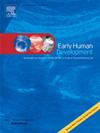高危极早产儿的哭泣行为和情绪行为结果:一项前瞻性队列研究
IF 2.2
3区 医学
Q2 OBSTETRICS & GYNECOLOGY
引用次数: 0
摘要
5 - 20%的婴儿受到包括过度哭闹、睡眠和喂养困难在内的调节问题的影响。它们与后来的行为和情绪问题的关系尚不清楚,特别是在神经发育风险较高的早产儿中。方法本前瞻性观察研究纳入329例高危极早产儿(胎龄30周和/或出生体重1000 g)。在矫正年龄3个月和6个月时收集父母的哭泣行为报告(小时/天)。在12个月时使用简要婴幼儿社会和情感评估(BITSEA)和24个月时使用儿童行为检查表(CBCL)评估情绪和行为结果。进行单变量和多变量线性回归,校正围产期危险因素和母亲特质焦虑。结果329例新生儿中,男婴占56%;平均胎龄28周),42例(13%)在3月龄时出现EC(≥3小时/天)。在单变量分析中,哭泣行为与较高的BITSEA问题得分相关(β = 0.187, p = 0.009),但在多变量分析中无相关(β = 0.157, p = 0.215)。哭泣行为与CBCL内化或外化得分在单变量上无显著相关性(β = 0.066, p = 0.459;β= 0.038,p = 0.672)或多变量分析(β= 0.301,p = 0.052;β = 0.202, p = 0.222)。母亲特质焦虑与较高的BITSEA问题得分显著相关(β = 0.353, p = 0.006)。结论在极早产儿中,哭闹行为与情绪或行为问题无关,为家庭提供了保证。进一步的研究应探讨其对其他发展领域的影响。本文章由计算机程序翻译,如有差异,请以英文原文为准。
Crying behavior and emotional-behavioral outcomes in high-risk very preterm infants: A prospective cohort study
Purpose
Regulatory problems (RPs), including excessive crying (EC), sleeping, and feeding difficulties, affect 5–20 % of infants. Their association with later behavioral and emotional problems remains unclear, particularly in preterm populations at elevated neurodevelopmental risk.
Methods
This prospective observational study included 329 high-risk very preterm infants (gestational age <30 weeks and/or birthweight <1000 g). Parental reports of crying behavior (hours/day) were collected at three and six months corrected age. Emotional and behavioral outcomes were assessed using the Brief Infant-Toddler Social and Emotional Assessment (BITSEA) at 12 months and the Child Behavior Checklist (CBCL) at 24 months. Univariable and multivariable linear regressions were conducted, correcting for perinatal risk factors and maternal trait anxiety.
Results
Among 329 infants (56 % male; mean gestational age 28 weeks), 42 (13 %) exhibited EC (≥3 h/day) at three months of age. Crying behavior was associated with higher BITSEA problem scores in univariable analysis (β = 0.187, p = 0.009), but not in multivariable analysis (β = 0.157, p = 0.215). No significant associations were observed between crying behavior and CBCL internalizing or externalizing scores in univariable (β = 0.066, p = 0.459; β = 0.038, p = 0.672) or multivariable analysis (β = 0.301, p = 0.052; β = 0.202, p = 0.222). Maternal trait anxiety was significantly associated with higher BITSEA problem scores (β = 0.353, p = 0.006).
Conclusion
In very preterm infants, crying behavior was not associated with emotional or behavioral problems, offering reassurance to families. Further studies should explore its influence on other developmental domains.
求助全文
通过发布文献求助,成功后即可免费获取论文全文。
去求助
来源期刊

Early human development
医学-妇产科学
CiteScore
4.40
自引率
4.00%
发文量
100
审稿时长
46 days
期刊介绍:
Established as an authoritative, highly cited voice on early human development, Early Human Development provides a unique opportunity for researchers and clinicians to bridge the communication gap between disciplines. Creating a forum for the productive exchange of ideas concerning early human growth and development, the journal publishes original research and clinical papers with particular emphasis on the continuum between fetal life and the perinatal period; aspects of postnatal growth influenced by early events; and the safeguarding of the quality of human survival.
The first comprehensive and interdisciplinary journal in this area of growing importance, Early Human Development offers pertinent contributions to the following subject areas:
Fetology; perinatology; pediatrics; growth and development; obstetrics; reproduction and fertility; epidemiology; behavioural sciences; nutrition and metabolism; teratology; neurology; brain biology; developmental psychology and screening.
 求助内容:
求助内容: 应助结果提醒方式:
应助结果提醒方式:


